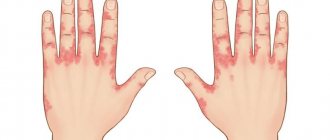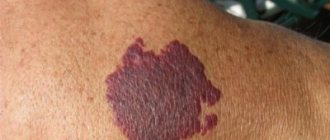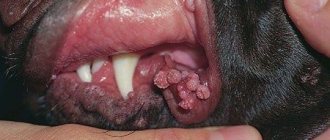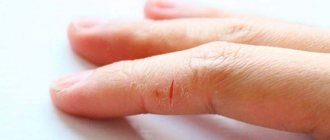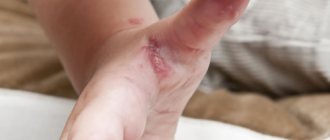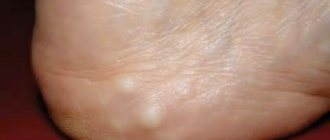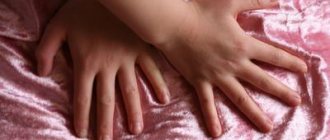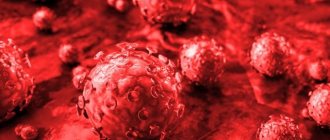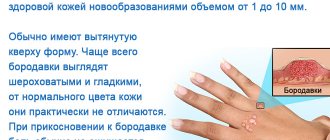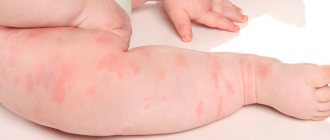Causes of blisters in children
The appearance of blisters on the skin can occur for various reasons.
Each type of disease has its own characteristics and requires special diagnostics. Damage to the body by infectious diseases contributes to malfunctions of internal organs, which often appear on the skin in the form of various types of blisters with fluid inside.
In infants, formations with fluid may appear for the following reasons:
- Herpes – watery pimples appear in the mouth, nose and genitals. After a few days, the blister becomes purulent and can spread to healthy areas of the skin;
- Streptoderma is the formation of large purulent blisters on the skin, most often appearing in the face area, after which it spreads throughout the body;
- Enterovirus is a viral infection of the body in which blisters with liquid appear, which tend to form in almost any part of the body;
- Pemphigus is the appearance of a watery rash with a rim around the formation. Most often occurs in the oral cavity on the abdomen and arms;
- Allergic rash - most often occurs on food, appears on the face in the form of papules with purulent content;
- Miliaria is a fairly common phenomenon in newborn children, especially in the summer, in the heat, since their skin is very sensitive to temperature changes and any other irritants.
Very often, blisters appear on the skin of newborns as a result of poor-quality clothing that causes irritation.
In childhood, the following factors most often contribute to the appearance of blisters:
- Chicken pox is caused by an infection that is transmitted by airborne droplets. The disease begins its symptoms in the facial area and gradually spreads to the whole body;
- Herpes zoster manifests itself as small blisters that become cloudy after three to four days. Most often it forms in the head, back, shoulders, arms;
- Burns – occur under the influence of external factors on the child’s skin and are manifested by the formation of large blisters with liquid.
In addition, common causes of watery acne are allergic reactions and malfunctions of internal organs.
Any type of rash on the body during pregnancy may indicate the presence of malfunctions in the functioning of internal organs and requires detailed diagnosis.
The most common reasons:
- Urticaria is most often formed as a result of the body’s reaction to food. Localized in the arms, abdomen, face. Accompanied by itching and looks like blisters with liquid contents;
- Miliaria - occurs most often in the last stages of pregnancy in the summer. Pimples with liquid contents form in the folds of the skin and under the abdomen; after damage to the membrane, a crust forms that itches and burns;
- Chicken pox - affects women if they have not previously had this type of disease;
- Dermatosis of pregnant women - forms in places where stretch marks form and manifests itself as blisters of a transparent color. Very often, this type of rash goes away on its own and does not require special treatment.
In addition to the main types of diseases that affect the period of bearing a child, a woman is not protected from the risk of contracting herpes or scabies, which also have symptoms such as the formation of blisters on the body.
Each type of disease requires a special type of treatment.
Allergy
Zyrtec Suprastin Diazolin Fenistil Akriderm SK Bepanten
Scabies
For the treatment of scabies it is recommended:
- Preparations containing sulfur, for example Sulfur ointment;
- Synthetic antiparasitic agents – Spregal, Benzyl benzoate;
- Antiseptic skin treatment, for example Medifox.
Sulfur ointment Spregal Benzyl benzoate Medifox
Neurodermatitis
Neurodermatitis is eliminated as follows:
- Anti-allergy medications – Erius, Tavegil;
- Anti-puffiness of the skin - Boric ointment;
- Vitamins.
Erius Tavegil Boric ointment
Herpes and lichen
For the treatment of herpes and lichen, the following is most often used:
- Antiviral agents – Acyclovir;
- Anti-inflammatory drugs – Meloxicam, Naproxen;
- Local therapy - Fukortsin, Pentsivir.
Acyclovir
Meloxicam Naproxen Fucarcin Pencivir
Chicken pox
For chickenpox it is used:
- Antiviral drugs - Famvir tablets;
- Zelenka for local therapy.
Famvir Zelenka
Pathogenic fungi
To eliminate pathogenic fungi, the following is used:
- Local treatment to eliminate the infection - Mikoseptin, Ifenek;
- Antifungal agents – Lamisil, Flucanazole.
Mikoseptin Ifenek Lamisil Fluconazole
All treatment methods and drugs are used strictly as prescribed, after being prescribed by a specialist.
The use of folk remedies can reduce unpleasant symptoms and eliminate the appearance of skin rashes:
- Peach oil – reduces the likelihood of damage to formations, eliminates itching. Apply a small amount of oil to the affected area and leave until completely absorbed. Not for use in case of individual sensitivity to the component;
- Baths with medicinal herbs help provide an antibacterial effect and eliminate itching. It is necessary to mix chamomile flowers, calendula, nettle leaves, and oak bark in equal proportions. Pour water over all ingredients and bring to a boil. Leave to infuse for 30 minutes, strain and add to a bath of water. Use this bath every day for 20 minutes. It is forbidden to dry yourself with a towel; you must carefully blot the liquid;
- Aloe juice has antibacterial and antiviral properties. Grind the aloe leaf and soak it in water for several hours. Strain the mixture, moisten a piece of gauze, apply to the damage for 20 minutes;
- Series - used to relieve inflammation. Bring a small amount of herb to a boil, cool and strain. Moisten a cotton swab and apply to the rash on the epidermis. Used during pregnancy and from the first days of life.
We suggest you read: Does vaccination protect against disease?
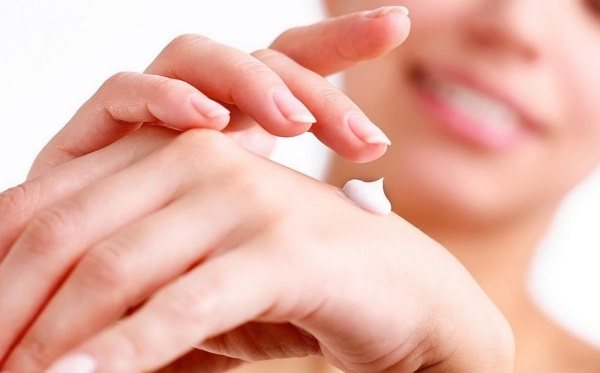
Before using traditional medicine measures, it is necessary to conduct a sensitivity test.
To reduce the risk of papules forming on the epidermis, the following prevention methods must be followed:
- Following a diet that reduces the consumption of allergenic foods;
- Do not use other people’s personal hygiene products and utensils;
- Avoid stressful situations;
- Increase the protective functions of the immune system with the help of vitamins;
- Treat all types of diseases in a timely manner;
- Avoid visiting public places during periods of exacerbation of viral infections;
- Maintain proper body hygiene;
- Reduce the risk of contact with infected people.
Following simple prevention rules will reduce the likelihood of infection and eliminate long-term treatment.
Watery blisters on the skin, vesicles, are hollow formations filled with serous fluid. Vesicular rashes are blisters that occur as a result of a viral infection. They can appear on the entire surface of the skin, and in some cases on the mucous membrane of the mouth. The term "vesicular" comes from the Latin name "vesiculum", meaning "small sac".
Fluid accumulates in the sacs and may be clear, white, yellow, or bloody. They have a diameter ranging from 5 to 10 mm. In the initial stage of the rash, the blister is covered with the epidermis. Subsequently, inflammation occurs at the base of the blister and the skin around it. In many cases, the watery formations are destroyed and the liquid gets onto the skin, which begins to become constantly wet.
Erosion occurs around the released fluid. After drying, crusty formations remain on the skin. Some blisters filled with purulent fluid turn into pustules larger than 6 mm in size. In this case, the inflammatory process affects not only the skin, but also the fatty tissue under the skin. Bubbles larger than 10 mm filled with erosive fluid are called bullae.
The appearance of bubbles is influenced by external and internal factors:
- burns;
- contact dermatitis:
- herpes;
- allergic reactions;
- autoimmune disorders;
- skin diseases;
- bacterial infections;
- fungal infections;
- atopic dermatitis.
The appearance of watery formations not associated with internal diseases can be prevented:
- When washing premises or dishes using chemicals, you should wear rubber gloves.
- When you come home or work, you should wash your hands every time.
- Wear gloves in the cold season, especially in autumn, when there is a sharp change in air temperature.
- Avoid stressful situations.
- Carry out septic treatment of skin abrasions and cracks that appear.
- Avoid contact with products and substances that cause allergies.
- If you stay in the sun for a long time, you should protect your body from burns and use sunscreen.
Treatment for a rash usually begins with addressing the underlying cause. Therapy includes a combination of medications and home remedies, depending on the patient's condition.
Watery blisters on the skin accompanied by other symptoms, such as inflammation or infection, require medications to reduce inflammation and eliminate bacteria.
These may include oral antibiotics to prevent the effects of the vesicles from getting worse. For eczema, retinoids and glucocorticoids are prescribed. Blisters caused by burns are treated with prescription creams and ointments. Oral antibiotics are prescribed to reduce the chance of infection. Antihistamines are designed to eliminate blisters caused by allergies.
| Type of disease | Drugs | Well | Price in rub. |
| Herpes rashes | Zovirax | From 4 to 10 days, treatment 2 times a day, | 150 |
| Acyclovir | ointment treatment up to 5 times a day | 112 | |
| Scabies | Spray "Spregal" | Apply to the skin in the evening for 8-10 days | 800 |
| Emulsion "Benzyl benzoate" | Rub in for 10 minutes for 2 days. | 18 | |
| Vesicles caused by fungi | Lamisil | Apply once a day for 1 week | 450 |
| Zalain | 2 times a day until the bubbles disappear | 400 | |
| Vesicles caused by eczema | Hydrocortisone ointment, | Apply a thin layer no more than 4 times a day | 25 |
| Castellani liquid or Fukortsin | Moisten with a tampon 4 times a day | 23 | |
| ointments with ketoconazole, | 1 time per day for 7 days | 100–200 | |
| Triderm | Duration of treatment is individual | 600 | |
| Burn blisters | Belanten ointment | Apply 1–2 times a day | 400 |
| Allergy blisters | Claritin | 1 tablet per day | 200 |
| Erius | 5 mg per day | 300 | |
| Smecta | 2 sachets per day | 130 | |
| Hydrocortisone | Apply a thin layer no more than 2 times a day | 26 |
Principles of treatment
Treatment depends entirely on the source of the rash. Hospital admission is usually not required; skin irritation can be treated at home. Most likely, the specialist will prescribe antibacterial, hormonal ointments, antibiotics, and a special moisturizer. You should not self-medicate, as this can only cause harm, because hormonal ointments, for example, are not used for children under 7 years of age, and almost all medications have side effects and contraindications.
Psoriasis
A rash in the area of the elbow joints is a characteristic sign of psoriasis. This is a hereditary disease, it can appear at any age, its causes have not been studied. Perhaps this is a metabolic disorder, stress, the consequences of past infections or skin damage. Psoriasis manifests itself as redness and peeling of the skin. If the disease is started, it will cover a large area and will be difficult to treat. Complications can include inflammation in the joints and arthritis.
A child with psoriasis is bothered by severe itching; acne occurs at the initial stage of the disease. Birch tar, medicinal baths with the addition of celandine, ozone therapy and phototherapy will help relieve symptoms. Doctors usually prescribe hormonal drugs, Ichthyol or Salicylic ointment, antihistamine tablets and local preparations with zinc.
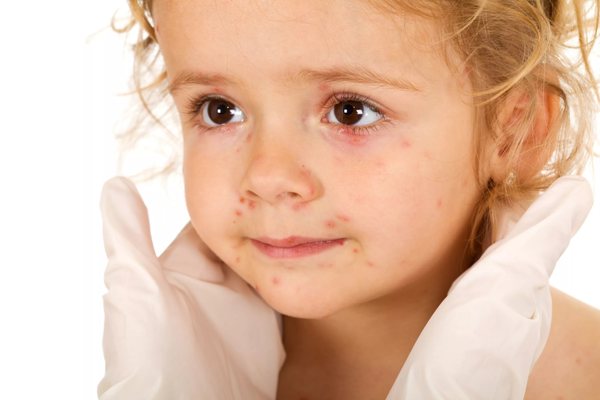
In advanced cases, allergies grow to the size of atopic dermatitis. It looks like small pimples that are very itchy. An allergen can be anything, often food, household chemicals, medicines and much more. To determine the cause of the allergy, the doctor will prescribe special tests; contact with the allergen must be eliminated. The rashes are most often localized on the inner surface of the elbow, on the legs, wrists, but can appear on any part of the body.
We suggest that you familiarize yourself with Treatment of warts on the feet in children
In children, atopic dermatitis occurs due to weakened immunity and gastrointestinal disorders. It is treated with antihistamines and external agents: Erythromycin and Lincomycin ointments, and, if necessary, antibiotics.
Eczema
The rash usually appears on the inside of the elbow and on the knees. In the initial stage, eczema looks like small blisters under the skin. They itch and when damaged, fluid is released. Eczema pimples can be a complication of atopic dermatitis.
If eczema appears in an infant, the mother needs to follow a diet and limit allergenic foods. Remove all possible sources of allergies from the interaction area: dust, pets, down pillows, etc. To relieve the symptoms of eczema, sedatives, Tar ointment, Naftalan paste, Panthenol, Bepanten are usually prescribed. You can see what eczema looks like in the photo.
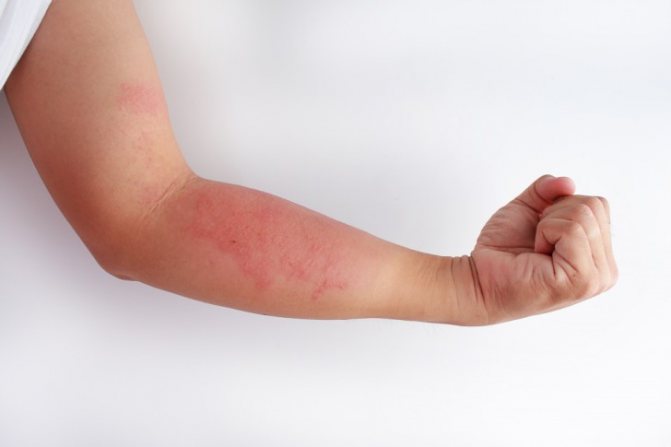
Granuloma annulare affects mainly children under 10 years of age. Pimples appear on the elbows, knees and hands and often go away on their own without treatment. This disease is not dangerous and is chronic.
The causes of granuloma annulare are not fully understood. It is believed that it is inherited. It can appear and then disappear for no apparent reason. To treat granulomas, non-steroidal local agents, corticosteroid and hormonal ointments are used. The lesions are injected with Acetonide or Diapsone.
Mycosis is a fungal skin disease. Most often it appears in places with high humidity: on the inside of the elbows and knees, between the fingers, in the groin area. Mycosis causes severe itching. A rash rarely appears on the elbows only if infection has occurred through this area or an advanced form has spread.
Mycosis is treated with local remedies: Mikozolon, Mikoseptin, Mifungar. Diflucan, Griseofulvin and others are taken internally.
Follicular keratosis, popularly called pimples, is usually localized on the skin of the arms above the elbow and on the fingers. The rash is accompanied by dryness and slight itching. Chicks occur due to a lack of vitamins, exposure to a stressful situation, cold, and endocrine disorders.
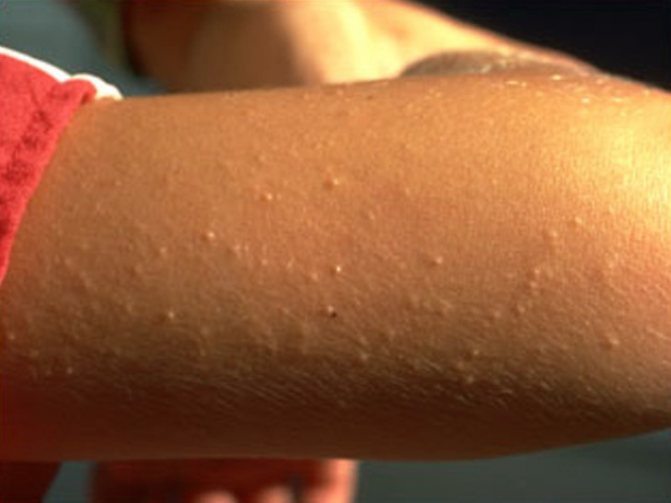
Treatment for keratosis pilaris depends on the cause of its appearance. Usually, special ointments, proper nutrition, exclusion of allergens, vitamin therapy, and quartz treatment of the skin are prescribed.
This is a viral disease and can be contracted through household means. Local manifestations look like dense white pimples (see also: pimples appear on the cheeks of a newborn). If you press on them, you can discern the white contents. The rashes are quite large, usually located in the elbow, under the knee, under the armpits. You should not allow your child to scratch the rash, because then the disease will quickly spread throughout the body.
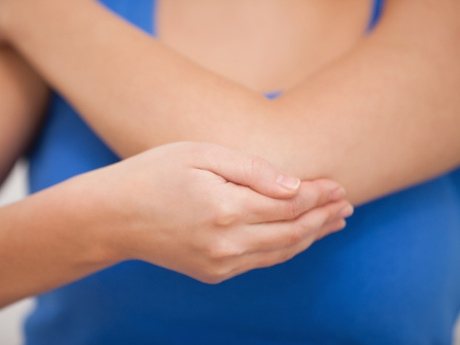
Experts believe that the child’s body must overcome the disease itself by developing immunity to it, so no specific treatment is prescribed. The doctor can only prescribe drugs to increase general immunity, remove rashes with liquid nitrogen, and in severe cases, antibiotics. In the photo you can distinguish the characteristic features of molluscum contagiosum.
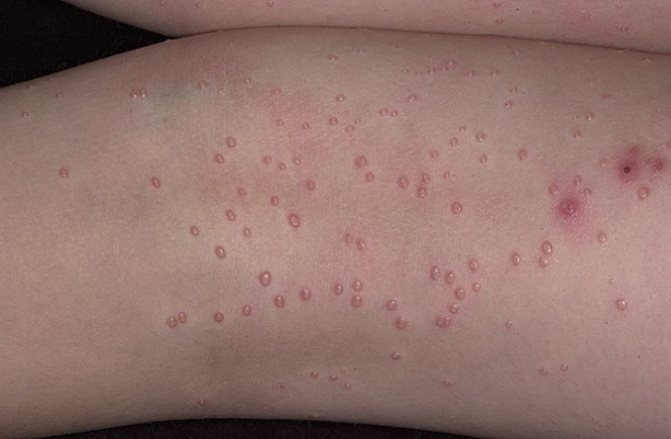
Molluscum contagiosum
Hives
Hives blisters are a manifestation of an allergic reaction of the body. The site where the rash appears swells and looks like a nettle burn, hence the name. With proper treatment with antihistamines, it goes away quickly. Urticaria is treated with Zodak, Claritin, hormonal agents, and enterosorbents.
Scabies
Thin and dry skin on the elbows is a favorite habitat for scabies mites. At first the pimples are small and red in color, then they turn into watery blisters. Scabies is accompanied by severe itching, which gets worse at night. Scabies spreads through household means - it can easily be contracted in transport, clinics, schools or kindergartens.
If the doctor detects scabies, all family members will have to be treated. All clothing and bedding will need to be thoroughly processed. Scabies is treated with antihistamines, sulfur ointment, and lotions. During treatment, not only the affected area is treated, but also healthy skin of the entire body.
Allergy
A red rash on the elbows is a manifestation of an allergy. It also causes itching and flaking. In this case, exclude the child from interacting with the allergen. A pediatric allergist will prescribe antihistamines to relieve symptoms and local remedies to relieve inflammation.
The main goal of therapy is to reduce the appearance of new blisters and heal old wounds. If everything is done correctly, the child will not have any traces of the lesion. You need to start with medications.
Photo from e-wiki.org
Medicines will help stop the appearance of watery blisters on your child’s skin. Most of them are symptomatic remedies; they eliminate discomfort and skin irritation. If the source of the rash is a serious illness, the doctor will adjust the treatment.
We suggest you familiarize yourself with White pimples in a child’s butt
List of medications for skin blisters:
- antihistamines (Tavegil, Suprastin) - help with allergies;
- healing agents (Panthenol, Solcoseryl) - accelerate recovery processes;
- antibiotics (Clotrimazole, Cefazolin) - used for bacterial infection;
- antiviral drugs (Interferon, Remantadine) - often prescribed for herpes;
- antifungal agents (Terbinafine, Miconazole) - help well in identifying the pathogen.
It is better to carry out comprehensive treatment, including the use of ointments and tablets. To strengthen the body, you can prescribe vitamins to your child (Undevit, Complivit). Therapy without identifying the provoking factor is ineffective.
Treatment according to the prescriptions of traditional healers refers, rather, to strengthening procedures than to basic therapy. When drawing up a program, you must know the reason for the formation of blisters, this will help you choose an effective recipe:
- for prickly heat - homemade flour is suitable, which is used to sprinkle blisters on the skin;
- for burns - fir oil, aloe juice, St. John's wort tincture;
- against insect bites - plantain leaf, applying chilled raw vegetables.
There are no folk remedies for allergies, psoriasis and other serious diseases. To treat these pathologies, it is better to resort to traditional medicine.
Classification and manifestation of fluid blisters
Blisters on the skin that contain fluid inside are classified according to the following classification:
- Symptomatic;
- Allergic blisters;
- Mechanical effect on the skin.
This type of formation is one of the main symptoms of an infectious disease.
Formations appear as follows:
- Small blisters form;
- The formation contains a clear liquid;
- The thin film on the formation is quickly damaged and turns into a wound;
- It can form in almost any part of the body.
We invite you to familiarize yourself with how a child is baptized in the Orthodox Church: stages of the sacrament
They are a symptom of skin surface contact with an allergen. Very often, allergic rashes appear after using low-quality cosmetics or contact with plants.
- Redness appears on the skin, which turns into a large number of small blisters with liquid;
- The formations create a large number of unpleasant sensations for a person, including a feeling of itching;
- They tend to disappear quickly after using antihistamines;
- Most often they appear on the arms, shoulders and legs.
The appearance of such blisters is promoted by contact with hot objects and direct sunlight, as well as damage to the epidermis.
Such formations have the following properties:
- Large blisters;
- Occurs directly at points of contact;
- Can persist for a long time;
- Upon palpation, a person feels pain;
- After the bubble is damaged, a wound is formed in its place;
- Most often they occur on the arms, legs, and shoulders.
When this kind of blisters appears on the body, it is forbidden to comb them and damage their integrity, otherwise infection may occur and the disease may worsen.
What it is?
Blisters on the skin with liquid are lesions that look like peculiar bubbles located in the upper layer of the epidermis.
They can be of different sizes. Typically these bubbles are filled with plasma or serum. However, if there is an infection, there may be blood or pus under the skin.
Thanks to the accumulated fluid, the sore spot heals faster, since a “cushion” is created that prevents further mechanical damage to this area of skin.
Blisters are usually not something to worry too much about. After some time, they pass by themselves, leaving no trace.
What does it look like?
As a rule, watery blisters on the hand are outlined circles, slightly raised above the skin. Its shape can be either perfectly round or only vaguely reminiscent of this geometric figure.
The bubble feels quite dense to the touch. Liquid can be felt under a thin layer of skin. Usually it appears suddenly, and after some time (several hours or days) it completely disappears.
Blisters can be small or very large. It depends on the reason that caused them. The color of the blisters is often pale, slightly pinkish, and sometimes white. The damaged area may not be felt at all or may be accompanied by pain and itching.
What to do if you are itchy?
If the blisters itch and itch, they should not be scratched under any circumstances. It is not advisable to even touch them. Because this can introduce an additional infection, which will complicate the treatment process.
When itching cannot be tolerated, various ointments, cold compresses with herbs or soda are used. But the best option in such cases is to consult a doctor .
Causes
As a rule, small blisters on the hands appear, itch and itch as a reaction of the body to the influence of any internal or external factors. Also, such manifestations can serve as a symptom of an infectious disease .
Most often, such blisters on the hands appear due to the following reasons:
- An allergic reaction of the body to medications.
- A bite of an insect.
- Viral disease.
- Hand skin contact with detergents or cleansers.
- Burn (both chemical and thermal).
The following diseases can also cause blisters:
- Dyshidrosis of the hands;
Dyshidrosis is a dermatological type of disease. It manifests itself in the form of a large number of small water bubbles covering the skin of the hands from the outside and inside. They cause discomfort, itching, and cause severe inconvenience.
Experts believe that the main cause of this disease is serious problems in the functioning of the endocrine, nervous and digestive systems. If you avoid scratching, dyshidrosis will go away without consequences. However, any violation of the integrity of the blisters can lead to infection.
This disease is manifested by numerous rashes on the skin. There are red spots and small blisters that appear not only on the hands, but also on other parts of the body. The disease is accompanied by itching, an unpleasant burning and tingling sensation. The cause of dermatitis is also considered to be systemic disorders in the human body.
Bullous pemphigoid;
This disease most often occurs in older people. Pemphigoid is characterized by the appearance of blisters on the arms and legs. They usually itch and itch unpleasantly and cause severe psychological and physical discomfort. The cause of this disease is considered to be a dysfunction of the immune system.
Mycosis of the hands;
Mycosis is caused by pathogenic fungi (dermatophytes). This disease is manifested by itchy blisters, which can be found on the palms (both on the inside and outside), as well as on the fingers.
Hives;
This disease is allergic. It is characterized by the sudden onset of itchy blisters that usually go away after a few hours. Almost anything can be an allergen: medications, chemicals, foods, animal dander, etc.
Blisters on hands in the photo:
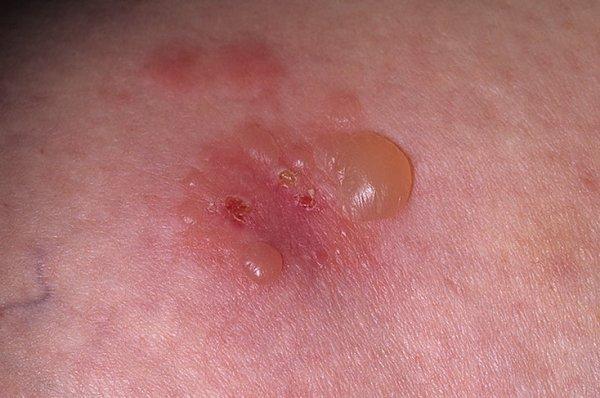
Dühring's dermatitis herpetiformis
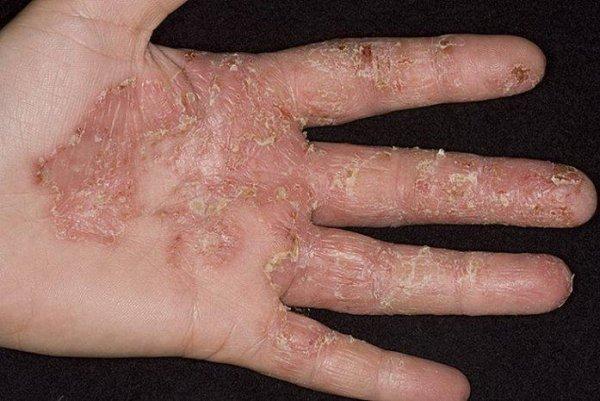
Stages and degrees of watery blisters
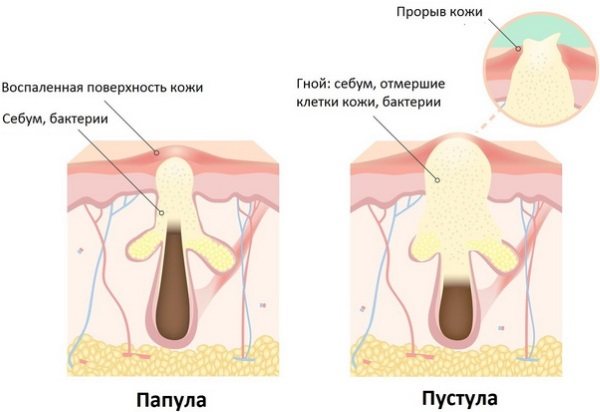
Blistering manifestations caused by imbalances in the body are the most dangerous skin rashes. They are associated with metabolic disorders, endocrine system disorders, and diseases of internal organs. Vesicles vary in color of the liquid that accumulates in the sacs.
Watery red blisters appear in the following cases:
- prolonged exposure to ultraviolet radiation;
- solarium abuse;
- contact with chemicals;
- injuries;
- animal bites;
- use of medicines;
- contact with chlorinated water;
- cold allergy.
In these cases, the surface layer of the skin reacts to the irritant with the appearance of watery blisters, itching, and swelling. If the contact with the irritant was short-lived, then the red bubbles quickly disappear.
In severe cases, they turn into bullae, subsequently causing weeping eczema. Rashes filled with white fluid are most often caused by a bacterial infection. These can be staphylococci, streptococci.
The cloudy color of the internal fluid of the vesicles is characteristic of infectious diseases:
- herpes;
- herpes zoster;
- chicken pox.
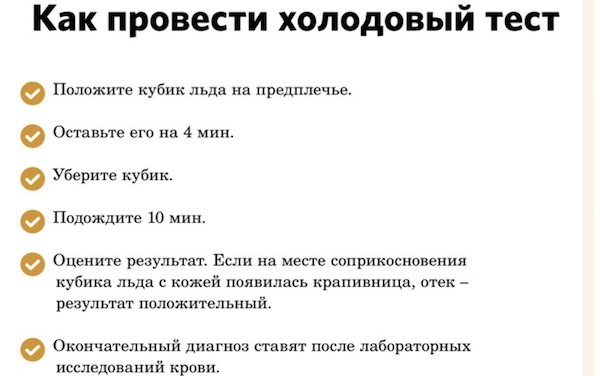
The epidermis constantly contains parasitic fungi, the negative effects of which are restrained by the immune system. In case of weakening of the body, due to injuries, favorable conditions are created for the proliferation of parasitic fungi, which causes mycosis. The areas most often affected are between the fingers, in the groin and armpits.
Watery blisters on the skin filled with blood signal autoimmune pathologies. This happens when the body's protective functions begin to perceive its own tissues as foreign. Such vesicles are a manifestation of the body’s autoimmune reaction.
They are symptoms of diseases:
- senile dermatitis herpetiformis;
- Dühring's dermatitis;
- pemphigus.
If a rash filled with clear liquid appears, we can say with confidence that the body has a malfunction of the thyroid gland, diabetes mellitus is developing, or the regulatory activity of the physiological system of the body is disrupted.
All these reasons have a negative impact on the condition of the skin. There is a violation of the physical and chemical structure of the epidermis, which is often manifested by the appearance of watery formations.
Allergic reactions
In this case, small bubbles are localized on the palms and fingers. As a rule, such formations indicate contact or chronic dermatitis. First, single blisters appear on the skin. Gradually there are more of them, and they combine into larger formations, under which the skin begins to peel off.
Gradually, the blisters on the fingers open, and infection penetrates into the damaged skin areas. This provokes the development of inflammatory processes.
As a rule, such allergic reactions occur due to taking medications, contact with the skin of chemicals (may be contained in detergents), food (if a person has an individual intolerance to certain components) and cosmetics.
Symptoms of diseases that cause watery blisters
If the blisters start to itch:
- Limit all possible contacts with the affected area (applies to infectious and viral diseases) healthy areas of the body can become infected;
- Apply a cold compress;
- Use an antihistamine (allergy and chicken pox);
- Treat with an antiseptic (for burns and calluses);
- Contact your doctor.
If necessary, a bandage can be applied to the area that is very itchy.
Watery blisters can develop as a sign of many skin conditions.
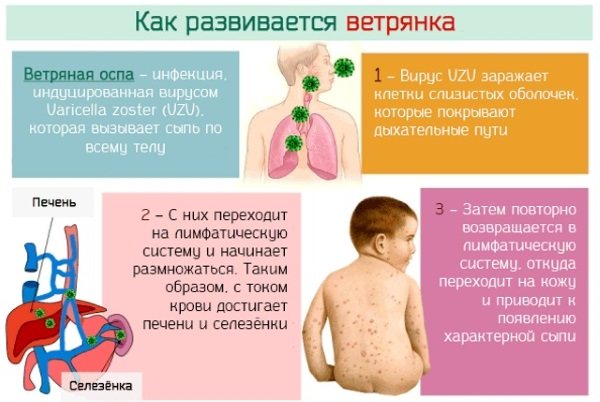
Watery blisters on the skin appear with chickenpox.
- Chicken pox. An itchy rash caused by the smallpox virus that resembles dew drops. The disease affects from 100 to 300 cells located in the mucous membranes of the throat, eyes, and genitals. Develops 10–21 days after exposure to the virus and 1–2 days after the onset of initial symptoms (headache, fatigue, fever). 8–12 hours after the bubbles appear, the liquid inside them becomes cloudy, they burst, forming a yellowish crust. New blisters appear at the healing sites, and subsequently a scar may appear.
- Shingles. A painful rash caused by reactivation of the same virus that causes chickenpox. Initial symptoms include burning, itching, and painful aching sensations where the rash appears. The virus invades nerve cells and reactivation develops along a nerve filament known as the dermatome, which is responsible for serving a specific area of skin on one side of the body or the other. When the blisters begin to rupture along the nerve strip, constant and excruciating pain occurs. The blisters heal within 7–10 days, but the pain may continue for months.
- Herpes. A disease caused by the herpes simplex virus. Once a person is exposed to herpes simplex, the virus takes up permanent residence in the body and occasionally causes rashes of watery blisters. Triggers for herpes outbreaks can include stress, fever, and excessive sun exposure. Herpes can be painful; the fluid contained in the blisters is transmitted to other people through kissing, sharing dishes and personal hygiene items. Healing occurs in 7–14 days, and the herpes disappears until the next outbreak.
- Dyshidrotic eczema. The itchy rash that develops with this disease affects the arms and legs. The disease is not contagious and is more common in people with atopic dermatitis. The rash visually resembles pudding; healing occurs no earlier than 3 weeks. It leaves behind red, dry, cracked scales.
- Scabies. Skin lesions caused by mites hiding under the epidermis. The red, bumpy rash turns into tiny, fluid-filled blisters. Appears on the wrist, between the fingers, under the arm and around the waist. Infection occurs through manual contact, through clothing and bedding.
- Dermatitis. Itchy rash, expressed by small blisters filled with liquid. Develops in response to a primary infection, usually fungal. The affected areas are on the sides of the fingers, on the chest and arms.
We suggest you read: How to properly reduce a high temperature in a child
Vesicles, pustules and bullae that appear are often symptoms of various diseases.
Based on the picture of the rash, the doctor diagnoses the disease:
- The infectious nature of the appearance of rashes caused by the herpes virus is small water blisters with slight inflammation around them.
- Herpes simplex - it is characterized by the appearance of watery, itchy rashes on the lips and wings of the nose.
- Chickenpox is the appearance of single-chamber small, rapidly bursting blisters, which are characterized by rapid drying.
- Dyshidrosis is a rash on the arms and legs that has a characteristic bright pink color and transparency.
- Smallpox - characterized by a rash of multi-chambered blisters.
- Scabies is a rash that appears on the abdomen and arms, causing severe itching.
- Allergic rash - characterized by the appearance of blisters 0.5 cm in diameter, filled with clear liquid.
Multiple rashes are called vesicular rash. It spreads quickly, the vesicles, as a rule, rupture and a yellowish crust forms in these places.
Causes
Small bubbles with cellular fluid over a large area of the body often appear after prolonged exposure to the sun. Under the influence of ultraviolet radiation, the surface layer of the skin is damaged, causing sunburn.
After a few days, the bubbles burst and the liquid comes out. With a deep burn, pain is felt, which is caused by the death of nerve endings. The skin peels off, and new cells form under the damaged layer.
In addition to ultraviolet radiation, the cause of burns is exposure to the skin of hot liquids, gases, and solid objects. The second degree of damage is accompanied by watery blisters.
You will learn more about what types of burns there are and how best to treat them in this article.
There is noticeable redness and swelling of the tissue around them. Later, the protein in the contents of the vesicles coagulates, the liquid becomes jelly-like and yellowish due to the presence of leukocytes.
A sign of a second degree burn is severe pain that disappears after a few days.
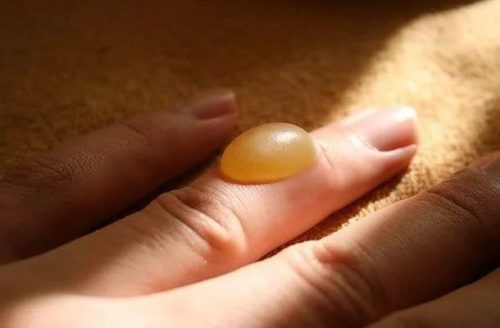
Prickly heat
The disease most often appears in newborns. White bubbles on the face and torso, no more than 2 mm in diameter, occur when the baby overheats and clothing comes into close contact with the skin. The so-called crystalline prickly heat does not cause discomfort in the child. The bubbles open on their own and tissue fluid flows out.
Attention! Shallow wounds form at the site of the rash in newborns. They may become infected. Don't start treatment!
Adults sometimes experience heat rash on the torso. The blisters with this disease take on a flesh-colored tint. In severe cases, they fill with blood or pus and form large lesions.
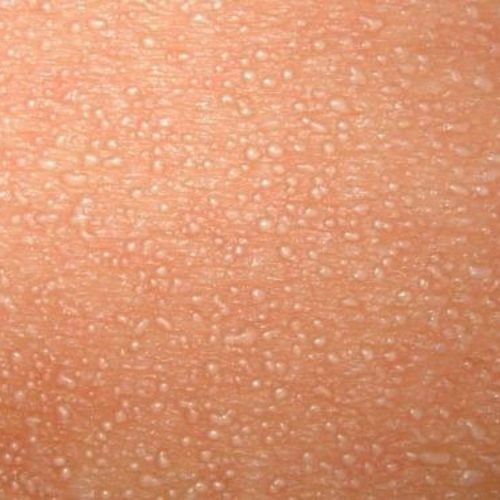
Herpes
The herpes simplex virus manifests itself on the mucous membranes of the mouth, around the lips, and in the nasolabial folds. The rashes on the skin are darkish, with redness. Swelling and redness around the vesicle is also called the area of hyperemia.
With herpes, the rash is painful. Over time, pimples dry out and ulcers and crusts form in their place. In severe cases of herpes, the temperature rises, nausea and weakness are felt. In herpetic neuritis, the rash follows the location of the intercostal nerves.
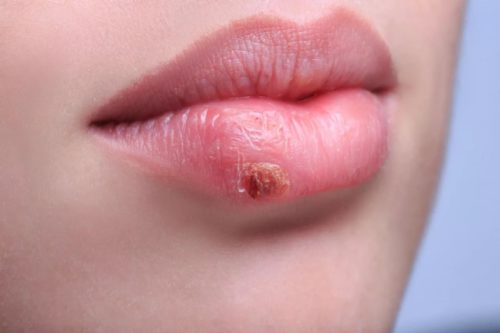
Chickenpox
Chickenpox is a disease caused by the herpes virus type 3. It most often occurs in children under 10 years of age, but can affect teenagers and adults. At the initial stage of the disease, the temperature rises and sometimes a cough occurs. The rash is located on all parts of the body, but especially in large quantities on the arms, legs and face.
The blisters on the body are filled with clear liquid and are very itchy. They quickly burst and small ulcers form in their place. During the recovery period, instead of a rash, a crust forms, which disappears on its own. Usually there is no scar left after healing. But if the blisters are scratched, scars form on the skin. It will be difficult to eliminate them later.
Chickenpox can affect not only children, but also adults. To be prepared to recognize the disease in your family, read this material.
After recovery from chickenpox, lifelong immunity is acquired. At the same time, the virus continues to circulate in the body. If the immune system is weakened, the disease may return in the form of shingles.
Diagnostics
The doctor makes the diagnosis of vesicular rash after a visual examination. When assessing the nature of the appearance of the rash, you should establish the time of appearance, the size of the bubbles, their shape and color.
Their quantity is diagnosed:
- nature of the rash: single or multiple;
- the ability to count the number of bubbles;
- profuse rashes.
If there is a suspicion that the rash is viral, a blood test is performed. Skin diseases can be detected by taking a biopsy of fluid from the blisters or skin tissue from the blister.
The differential diagnosis of vesicular rash is aimed at distinguishing the disease from other diseases, such as:
- smallpox;
- genital herpes;
- scabies;
- shingles.
When visiting a medical facility, the patient must undergo diagnostics, which includes:
- Visual examination of the patient;
- Blood donation;
- Antibody detection test;
- Submitting the contents of the blister for analysis;
- Scraping the pimple to identify the factor causing the rash.
If necessary, the doctor may order other types of tests to correctly prescribe the treatment method.
Infectious lesions
In this case, the formations are localized not only on the hands. Blisters may appear on the legs, stomach, and other parts of the body. In this case, the blisters come in different sizes and often look like a rash. Such infections are often called childhood infections, since children most often suffer from them.
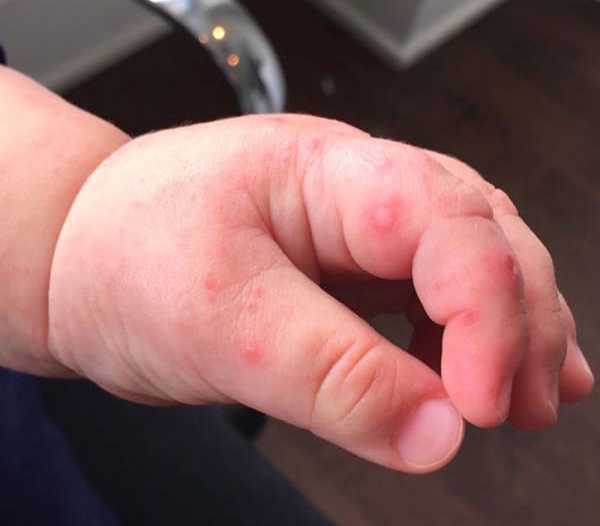
It is quite simple to independently diagnose the appearance of an infectious lesion. In this case, in addition to the appearance of blisters on the skin, the patient will experience an increase in body temperature and general malaise.
When it comes to scabies, similar redness on the hands appears as a result of scabies mite bites. Female insects lay eggs on human skin. Small blisters form at the site of masonry, which begin to itch very much. Unbearable itching is usually recorded at night.
In what cases is it necessary to consult a doctor?
Watery formations that occur as a result of allergies disappear quickly after taking antihistamines. A blistering rash that causes itching, pain, and redness is a reason to consult a doctor. Before you start getting rid of the rash on your own, you should visit a dermatologist and together with him determine the cause of its occurrence.
You should consult a doctor:
- when signs of infection appear, such as swelling, redness, increased temperature in the areas of greatest accumulation of blisters;
- with frequent appearance of vesicles for no reason;
- in case of painful blisters on one side of the body or face, which almost always indicates shingles;
- if you have a history of diabetes and small white blisters appear on your arms and legs.
If blisters form on the skin, you should seek help from a medical facility in the following situations:
- The blisters appeared for an unknown reason as a symptom of some disease;
- The formations arose in the child;
- The contents of pimples have purulent contents;
- The rash quickly spreads throughout the body;
- The rash is accompanied by unpleasant symptoms;
- The burn is large;
- The rash is accompanied by inflammation and swelling of the skin.
All types of skin rashes require consultation with a specialist; you should not self-medicate.
Which doctor should I contact if my child has blisters?
Since there are many reasons for the appearance of blisters, it is recommended to start looking for it by visiting a pediatrician.
The doctor can prescribe an examination immediately or refer you to a specialist, depending on the cause - an allergist, infectious disease specialist, rheumatologist, etc. If a rash is detected on the baby’s elbow, parents need to:
- contact a specialist to make a correct diagnosis and prescribe therapy;
- ensure the cleanliness of the rash location;
- Explain to the baby that you should not scratch the rash, otherwise you can easily get infected;
- for allergies – relieve local itching (you can use Fenistil gel).
Possible complications
Complications are usually related to the underlying cause of the vesicles. If they are caused by an allergic reaction or contact dermatitis, then after treatment and compliance with preventive measures, there may be no relapses.
If the appearance of vesicles was influenced by viruses, bacteria, or the genetic nature of the organism, then the return of vesicles can be repeated throughout life. In this case, proper and timely treatment can alleviate the symptoms. In chronic diseases, vesicles return again and again.
Watery blisters that appear on the skin are, for the most part, not a serious condition. But in most cases, this is a sign of infection or a complicated health condition. Therefore, it is better to start treatment as early as possible to ensure a quick recovery and avoid complications in the future.
What do formations look like?
Typically, people suffer from small blisters on their hands. The size of the formations ranges from 2 to 8 mm. The pimples themselves are round. They can be localized on the skin in the form of multiple rashes or individually. Sometimes watery blisters on the hands or feet are grouped together. In this case, large red ulcers form that are very itchy.
A clear, watery liquid can be seen inside the blisters even with the naked eye. If the contents of the swelling begin to change shade and become greenish or yellowish, this indicates the development of an infection. In some situations, the appearance of blisters with liquid on the hand is accompanied by pain and an increase in body temperature. In this case, we are talking about inflammatory processes occurring in the body.
The formations can remain on the skin from 3 hours to 1 week. If the cause of skin blisters is not diagnosed in a timely manner, new pimples will constantly appear in their place.
